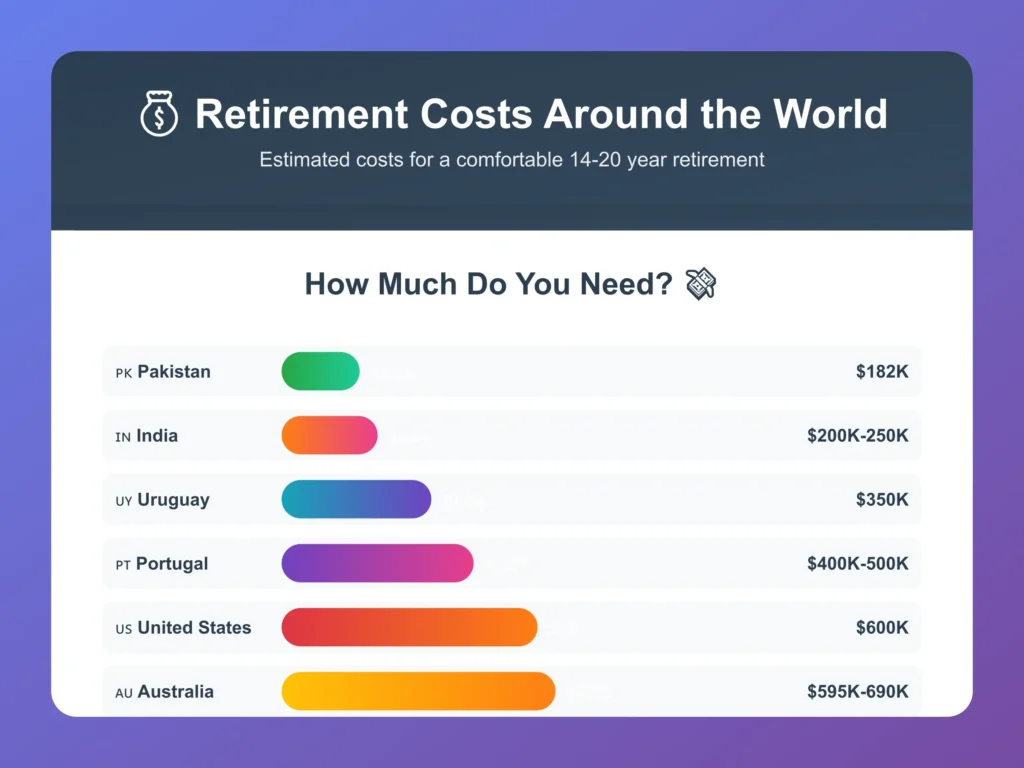Retirement:How Much Do You Really Need?
Retirement is no longer about scraping by—it’s about crafting a life of comfort and fulfillment. Whether you’re dreaming of serene European villages, vibrant tropical shores, or a cozy hometown, the cost of a comfortable retirement varies widely. The good news? You can live well in some countries for a fraction of what you’d spend in places like the U.S., U.K., or Australia. But the real key to retirement planning isn’t just geography—it’s lifestyle and personal priorities.
In this blog, we’ll break down retirement costs across countries, explore why these costs differ, and share practical insights to help you plan a retirement you’re excited to embrace.
How Much Does Retirement Cost Around the World?
Here’s a snapshot of estimated retirement costs for a comfortable lifestyle (not overly frugal or extravagant) over 14–20 years in various countries:
| Region/Country | Estimated Cost (USD) | Comments |
|---|---|---|
| Pakistan | ~$182,000 | Very low cost of living, affordable healthcare, and cheap housing. |
| India | ~$200,000–$250,000 | Low-cost services, food, and housing; quality medical care in cities. |
| Uruguay | ~$350,000 | Safe, stable, with a moderate lifestyle and good healthcare. |
| Portugal | ~$400,000–$500,000 | Expat-friendly, good infrastructure, and tax relief for foreigners. |
| United States | ~$600,000 | Varies by state; healthcare and housing can be costly. |
| United Kingdom | ~$680,000–$1,000,000 | Costs vary by region; London and the South East are pricier. |
| Australia (homeowners) | ~$595,000–$690,000 | Varies by city; Sydney and Melbourne are more expensive. |
| Switzerland | ~$900,000–$1,200,000 | High cost of living but excellent healthcare and safety. |
| Bermuda | ~$1,065,000 | High lifestyle costs due to import-driven economy. |
Note: These are rough estimates based on a comfortable lifestyle, including housing, healthcare, and leisure.
Why Do Retirement Costs Vary So Much?
Several factors drive the wide range of retirement costs:
1. Cost of Living and Currency Strength
Countries with weaker currencies compared to the U.S. dollar or Euro are often more affordable for retirees with global income. For example, Pakistan and India offer low-cost living, stretching savings further.
2. Healthcare Systems
Nations with subsidized or universal healthcare, like Australia or Thailand, reduce out-of-pocket medical costs, allowing retirees to allocate funds elsewhere.
3. Lifestyle Choices
Even within the same country, costs vary based on whether you rent or own, travel frequently, or dine out often. A couple in Portugal might live modestly or extravagantly, depending on their preferences.
4. Government Incentives
Some countries actively attract retirees with benefits:
- Portugal: Offers the Non-Habitual Residency scheme with favorable tax treatment for 10 years.
- Malaysia: The “Malaysia My Second Home” (MM2H) program provides affordable long-term stays.
- Panama: The Pensionado visa includes discounts on local goods, transportation, and services.
Key Considerations for Retirement Planning
1. Align Savings with Lifestyle, Not Just Location
While location matters, your retirement vision is critical. Do you want to travel extensively, live rurally, or rely on public transport? The traditional advice of saving 80% of pre-retirement income or 10–12 times your annual income is a starting point, but tailor it to your unique goals.
2. Weigh Country-Specific Benefits and Risks
Retiring abroad can offer perks but also challenges:
- Benefits: Tax incentives, lower costs, and vibrant expat communities.
- Risks: Political instability, language barriers, or distance from family.
3. Healthcare: The Hidden Budget Factor
Healthcare costs can make or break your budget:
- Thailand: Private hospitals offer excellent care at a fraction of U.S. prices.
- United States: Medicare kicks in at 65, but supplemental policies and out-of-pocket costs can add up.
- Australia: Medicare covers residents, but private insurance is common for faster service.
4. Australia’s Retirement Landscape
Australia’s superannuation guarantee recently increased to 12%, boosting savings for younger workers. For homeowners, a comfortable retirement costs around $595,000 for singles or $690,000 for couples, assuming a moderate lifestyle with dining out and occasional travel. Renters face higher costs due to rising rental prices.
5. U.S. Retirement Realities
Many Americans estimate needing $1.26 million for a comfortable retirement, yet average savings are under $100,000. With average monthly expenses around $5,000 ($60,000 annually), savings can deplete quickly without Social Security or other income. Costs vary significantly—$500,000 may suffice in the Midwest, but coastal areas often require over $1 million.

6. Real-Life Retirement Stories
- Albert Greenwood, a New York retiree who moved to Nepal in 2023: “We live comfortably in a way that would’ve cost much more in the U.S.”
- Jane and Mark Walters, a British couple in Portugal: They cut annual expenses by nearly 40% while enjoying a better quality of life with warm weather and fresh produce.
Practical Steps to Plan Your Retirement
- Start Early, Save Consistently: The sooner you save, the more compounding works in your favor. Even small increases in contributions add up over time.
- Estimate Expenses Realistically: Factor in housing, food, leisure, travel, and healthcare. Don’t underestimate discretionary spending.
- Test Drive Your Retirement: If moving abroad, spend a few months in your chosen destination to gauge fit.
- Diversify Income Sources: Combine pensions, investments, rental income, or part-time work for financial security.
- Stay Flexible: Health, costs, and preferences evolve. Build adaptability into your plan.
Conclusion: Design Your Dream Retirement
Retirement planning isn’t just about crunching numbers—it’s about envisioning your ideal future. Whether you’re drawn to the affordability of India, the charm of Portugal, or the familiarity of home, define your priorities:
- Lifestyle: Urban or rural? Active or relaxed?
- Health Needs: Access to quality, affordable care.
- Income Sources: Pensions, savings, or investments.
- Emotional Factors: Proximity to family or openness to new cultures.
With costs ranging from $200,000 in low-cost countries to over $1 million in high-end locations, a blend of research and personal stories can guide you to a plan that’s both practical and inspiring.
Your Next Steps
- Reflect: Where do you want to retire, and what lifestyle excites you?
- Research: Explore up-to-date cost-of-living and retirement data for your dream destinations.
- Act: Start saving, test potential locations, and build a flexible financial plan.
Retirement isn’t about the numbers alone—it’s about how you live once you get there.


